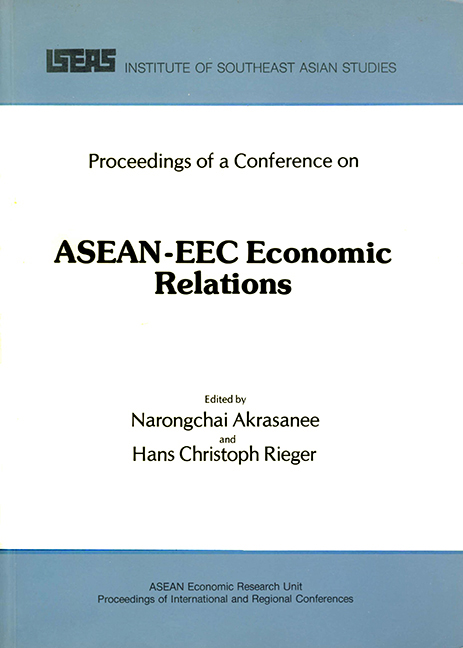FOREWORD
Published online by Cambridge University Press: 21 October 2015
Summary
Economic relations between the countries of the Association of Southeast Asian Nations (ASEAN) and the countries of the European Community (EC) have a long history as well as great future potential. Merchant adventurers, colonialists, traders, and foreign investors from Europe have in the last two centuries brought about a continuous exchange of goods, interests and ideas with Southeast Asia. In more recent times, mutual co-operation among the Southeast Asian countries of Indonesia, Malaysia, Philippines, Singapore and Thailand on the one hand and the European countries of Belgium, Denmark, France, Federal Republic of Germany, Ireland, Italy, Luxembourg, Netherlands, and the U.K. on the other have led to the creation of two economic groupings, ASEAN and the EC, dedicated to the idea of mutual benefits through trade. The EC is ASEAN's third most important trading partner, and, although the proportion of ASEAN's trade with the EC is declining slightly, the exchange of goods and services between the two groupings is still increasing rapidly both in terms of volume and value. ASEAN is important for EC investors as the fastest growing area of the Pacific rim. The political stability that has emerged in ASEAN is an important factor contributing to this attraction as well as an important reason why ASEAN as a grouping can expect to achieve more at the economic bargaining table than may be commensurate with the relatively low importance of ASEAN trade for the EC.
Although trade is likely to be beneficial for both sides it does not always develop automatically according to comparative advantage or investment potential. Lack of knowledge about available opportunities, methods of operation and styles of negotiation are frequent causes of missed chances. Dissemination of information, exchange of views and ideas and the analysis of potential opportunities are therefore important factors for trade expansion and consequent welfare increases. It is for this reason that research and academic exchange and co-operation have an important role to play.
- Type
- Chapter
- Information
- ASEAN-EEC Economic Relations , pp. vii - xPublisher: ISEAS–Yusof Ishak InstitutePrint publication year: 1981



